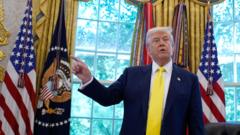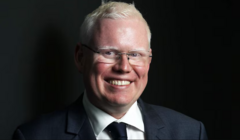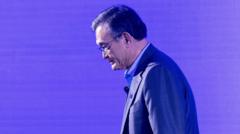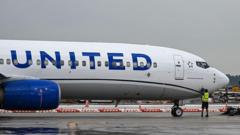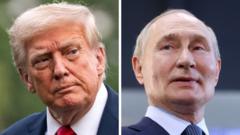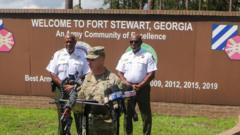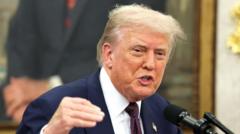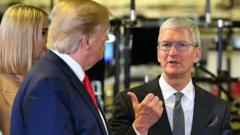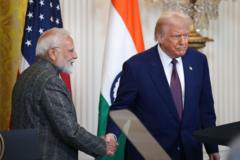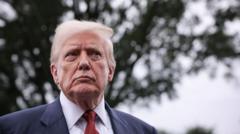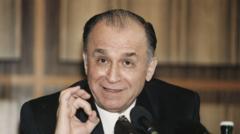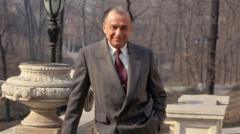Demonstrations led by the "No Kings" coalition marked a significant backlash against President Trump as he held a military parade, sparking protests in cities nationwide, highlighting tensions over immigration policies and the president's authority.
Massive Nationwide Protests Erupt Against Trump Amid Military Parade

Massive Nationwide Protests Erupt Against Trump Amid Military Parade
Citizens across the US rally in opposition to Trump as military celebration coincides with his birthday
In towns and cities throughout the United States, widespread protests erupted against President Donald Trump, mobilized by a group known as “No Kings.” These demonstrations were a direct response to a rare military parade that Trump hosted in Washington, D.C., coinciding with his birthday and marking the 250th anniversary of the US Army. The protests followed several days of unrest, especially in Los Angeles, where citizens gathered to voice their opposition to Trump's controversial immigration policies.
Lawmakers, union representatives, and activists took to the streets in major cities, including New York, Philadelphia, and Houston. Participants carried flags and signs criticizing the president’s actions, with many asserting the importance of defending democracy. Karen Van Trieste, a nurse participating in a Philadelphia demonstration, expressed her concern over Trump's drastic cuts to public health agencies as a catalyst for her involvement.
One of the largest gatherings occurred in Los Angeles, where tensions mounted as national guardsmen were deployed against local sentiment. Protester Jose Azetcla remarked on the moral implications of immigration policies, stating, “It’s not harsh, it’s evil. You don’t separate families.” The protests, characterized by a mix of peaceful marches and some confrontational incidents, showcased deep divisions among the populace regarding Trump's administration.
While millions took part across the country, the military parade itself faced scrutiny from multiple quarters. The ceremony, which Trump presided over, featured troops, tanks, and military vehicles. Critics, including some politicians and military figures, marked the event as an extravagant expenditure, with estimates between $25 and $45 million. Nonetheless, many attendees viewed the spectacle as a tribute to military service rather than a political statement.
This marked the first US military parade since 1991, an event that celebrated victory in the Gulf War. Although attendance on Saturday was lower than expected, thinning further with rain forecasts, veterans expressed appreciation for the honor given to troops. For some like Melvin Graves, a Vietnam War veteran, the event was a long-awaited expression of gratitude for service members.
Heightened divisions over Trump's immigration stance overshadowed the celebration, as experts noted the troubling juxtaposition of troops marching proudly while others were deployed to reign in protests. Safety concerns led to the cancellation of some protests in Minnesota, showing the complexity and volatility surrounding this administration.
In summary, these protests underscore intensified public sentiment against Trump's tactics, particularly regarding immigration and militarization, as the nation grapples with the broader implications of his presidency.
Lawmakers, union representatives, and activists took to the streets in major cities, including New York, Philadelphia, and Houston. Participants carried flags and signs criticizing the president’s actions, with many asserting the importance of defending democracy. Karen Van Trieste, a nurse participating in a Philadelphia demonstration, expressed her concern over Trump's drastic cuts to public health agencies as a catalyst for her involvement.
One of the largest gatherings occurred in Los Angeles, where tensions mounted as national guardsmen were deployed against local sentiment. Protester Jose Azetcla remarked on the moral implications of immigration policies, stating, “It’s not harsh, it’s evil. You don’t separate families.” The protests, characterized by a mix of peaceful marches and some confrontational incidents, showcased deep divisions among the populace regarding Trump's administration.
While millions took part across the country, the military parade itself faced scrutiny from multiple quarters. The ceremony, which Trump presided over, featured troops, tanks, and military vehicles. Critics, including some politicians and military figures, marked the event as an extravagant expenditure, with estimates between $25 and $45 million. Nonetheless, many attendees viewed the spectacle as a tribute to military service rather than a political statement.
This marked the first US military parade since 1991, an event that celebrated victory in the Gulf War. Although attendance on Saturday was lower than expected, thinning further with rain forecasts, veterans expressed appreciation for the honor given to troops. For some like Melvin Graves, a Vietnam War veteran, the event was a long-awaited expression of gratitude for service members.
Heightened divisions over Trump's immigration stance overshadowed the celebration, as experts noted the troubling juxtaposition of troops marching proudly while others were deployed to reign in protests. Safety concerns led to the cancellation of some protests in Minnesota, showing the complexity and volatility surrounding this administration.
In summary, these protests underscore intensified public sentiment against Trump's tactics, particularly regarding immigration and militarization, as the nation grapples with the broader implications of his presidency.

